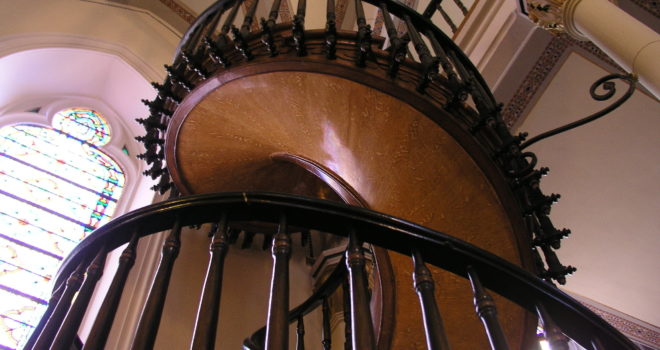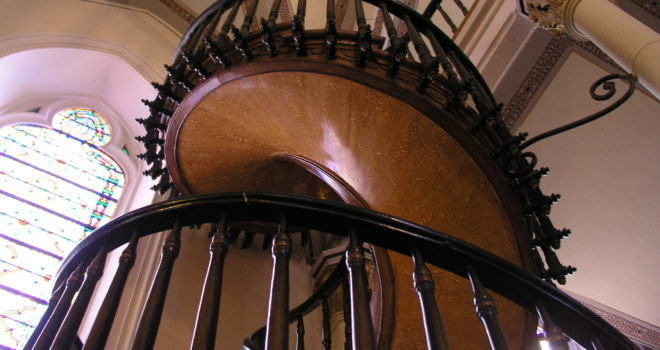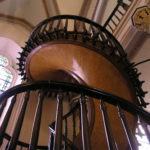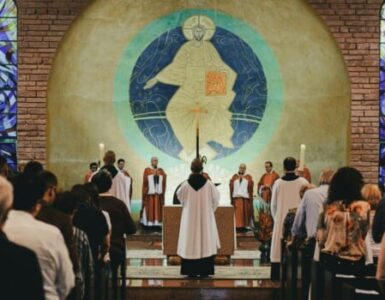Last year marked 140 years since the completion of the most famous staircase in our nation. It’s in the chapel of Our Lady of Loretto in Santa Fe, New Mexico. I hope that you know the story. In the 1870s in New Mexico, despite all the surrounding structures made of adobe, it was decided that a Gothic Church in the Gothic revival style would be built there in Santa Fe—with all the spires and the buttresses, even stained glass windows brought in from France.
It was beautiful – small but beautiful – save one crucial flaw. There was no staircase to the choir loft. You see, the architect died late in its completion and the excuse was, in that time, it just slipped through the cracks. And that loft was so high and the Church so narrow that a conventional staircase could not work. Despite this major flaw, the chapel was consecrated in 1878 with, yes, no stairs.
And it stayed like that for years. No carpenter could be found to complete the crucial project until mother superior and the sisters had just about enough and they decided to pray a novena asking the intercession of St. Joseph the carpenter. They spent nine days of prayer and, on the tenth day, a carpenter showed up with very basic tools in hand but with a promise to build them the stairs. They didn’t even know him. In fact, they knew even less at his departure than his arrival, for he left without saying goodbye or without even being paid for his work.
When they saw the staircase the word miraculous was used very quickly. As they looked even closer and they studied it, the term was used more often because the wood that was used in that staircase could not be found anywhere in the southwest. In fact, none of the lumber yards in the area knew of any order of it. Even to an unbeliever the spiral staircase was an engineering marvel, for there were no nails, no screws, no glue used in it. There was no central post, nor even a handle, along with the thirty-three stairs—one for each year of the life of our Lord before His cross. Now the Church has never officially declared it to be so, but the sisters were convinced that the carpenter was none other than St. Joseph himself.
The story of the miraculous stairs reminds us of some of the best qualities of mothers. First, they don’t despair. In a world with so much despair and darkness, those Sisters of Loretto inspire us. They could have easily given up. Remember it had been years of them praying in that chapel, the architect had died, and they were no good at shimmying up ropes to get up into the choir loft, but they didn’t give up. We know that Mary continually receives us as she received John into her life and entered into his home at the Cross. So, she watches out with hope and not despair for us.
Secondly, those stairs involved plenty of prayer. Who says a novena for something as mundane as stairs? But praying has power and moms sure know it. What mother out there doesn’t pray daily for her children? I know my mom sure does. And Holy Mother Church knows it too, giving life to her children. We entrust ourselves, our mothers, and our children, to the grace of Our Lord. Just like Mary, we remain in Him and He remains in us, in that spirit of love, as the Lord tells us in the Gospel.
And then, finally, those stairs and mothers offer just enough care. I find it very remarkable—most pictures of the stairs today show them seven years after their completion, when a railing was added. But, if it was Joseph who built them, when he designed them, there was no railing. And, you know what? It was scary. Thirty-three stairs making two complete rotations, over twenty feet up into the air with no railing, no net. Some of the nuns were so nervous that they would go up and down the stairs on their hands and knees. And a mother’s care for us as well, just enough, lifting us up. We love our moms for holding us so tightly, of course. But we also love them for letting us go, for trusting in the grace of God. Mary gives us that great example when Jesus left the caravan, and she and Joseph traveled for a day and a half back to Nazareth—before turning back to find Jesus, who they thought was in the caravan with them—only to find Him three days later in the temple.
Mary is no helicopter parent, the Church is no helicopter mother. We love God as we keep His commandments, in that motherly embrace of the Church. So as we come to the altar to be nourished, as a mother nourishes her child, we find hope. We find that our prayer is inspired, and that we can bring all of our cares to Him. And so we ask the intercession of the Holy Family, we say Our Lady of the Assumption—pray for us, St. Joseph—pray for us.
✠
Image: Spiral staircase in Loretto Chapel, Santa Fe, New Mexico: Shutterstock/Jim Buzbee














